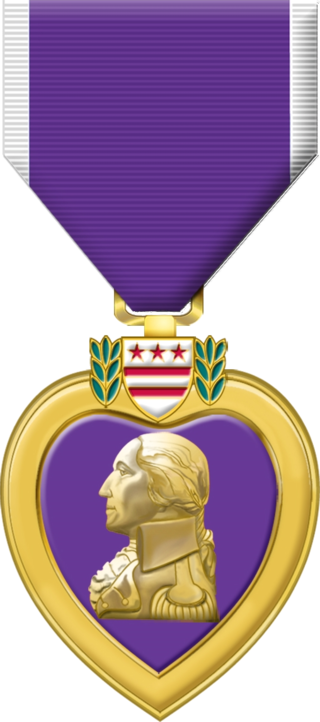
The Purple Heart (PH) is a United States military decoration awarded in the name of the president to those wounded or killed while serving, on or after 5 April 1917, with the U.S. military. With its forerunner, the Badge of Military Merit, which took the form of a heart made of purple cloth, the Purple Heart is the oldest military award still given to U.S. military members. The National Purple Heart Hall of Honor is located in New Windsor, New York.
The United States Armed Forces are the military forces of the United States. The armed forces consist of six service branches: the Army, Marine Corps, Navy, Air Force, Space Force, and Coast Guard. All six armed services are among the eight uniformed services of the United States.

The secretary of the Navy (SECNAV) is a statutory officer and the head of the Department of the Navy, a military department within the United States Department of Defense.
Rear admiral is a flag officer rank used by English-speaking navies. In most European navies, the equivalent rank is called counter admiral.

A coast guard or coastguard is a maritime security organization of a particular country. The term embraces wide range of responsibilities in different countries, from being a heavily armed military force with customs and security duties to being a volunteer organization tasked with search and rescue without law enforcement authority. In most countries, a typical coast guard's functions are distinct from those of the navy and the transit police, while in certain countries they have similarities to both.

A non-commissioned officer (NCO) is a military officer who does not hold a commission. Non-commissioned officers usually earn their position of authority by promotion through the enlisted ranks. In contrast, commissioned officers usually enter directly from a military academy, officer training corps (OTC) or reserve officer training corps (ROTC), or officer candidate school (OCS) or officer training school (OTS), after receiving a post-secondary degree.
Lieutenant Commander is a commissioned officer rank in many navies. The rank is superior to a lieutenant and subordinate to a commander. The corresponding rank in most armies and air forces is major, and in the Royal Air Force and other Commonwealth air forces is squadron leader. It is roughly equivalent to the Corvette Captain rank in central European countries and the Captain 3rd rank rank in eastern European/CIS countries.

The Boston Navy Yard, originally called the Charlestown Navy Yard and later Boston Naval Shipyard, was one of the oldest shipbuilding facilities in the United States Navy. It was established in 1801 as part of the recent establishment of the new U.S. Department of the Navy in 1798. After 175 years of military service, it was decommissioned as a naval installation on 1 July 1974.
A chief petty officer (CPO) is a senior non-commissioned officer in many navies and coast guards, usually above petty officer.

A jack is a flag flown from a short jackstaff at the bow (front) of a vessel, while the ensign is flown on the stern (rear). Jacks on bowsprits or foremasts appeared in the 17th century. A country may have different jacks for different purposes, especially when the naval jack is forbidden to other vessels. The United Kingdom has an official civil jack; the Netherlands has several unofficial ones. In some countries, ships of other government institutions may fly the naval jack, e.g. the ships of the United States Coast Guard and the National Oceanic and Atmospheric Administration in the case of the US jack. Certain organs of the UK's government have their own departmental jacks. Commercial or pleasure craft may fly the flag of an administrative division or municipality at the bow. Merchant ships may fly a house flag. Yachts may fly a club burgee or officer's flag or the owner's private signal at the bow. Practice may be regulated by law, custom, or personal judgment.
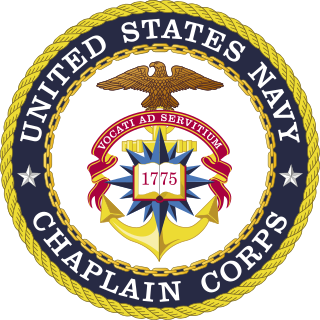
The United States Navy Chaplain Corps is the body of military chaplains of the United States Navy who are commissioned naval officers. Their principal purpose is "to promote the spiritual, religious, moral, and personal well-being of the members of the Department of the Navy," which includes the Navy and the United States Marine Corps. Additionally, the Chaplain Corps provides chaplains to the United States Coast Guard.

The Dental Corps of the United States Navy consists of naval officers with a doctorate in either dental surgery (DDS) or dental medicine (DMD) and who practice dentistry for Sailors and Marines to ensure optimal oral health.
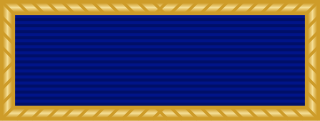
The Presidential Unit Citation (PUC), originally called the Distinguished Unit Citation, is awarded to units of the uniformed services of the United States, and those of allied countries, for extraordinary heroism in action against an armed enemy on or after 7 December 1941. The unit must display such gallantry, determination, and esprit de corps in accomplishing its mission under extremely difficult and hazardous conditions so as to set it apart from and above other units participating in the same campaign.
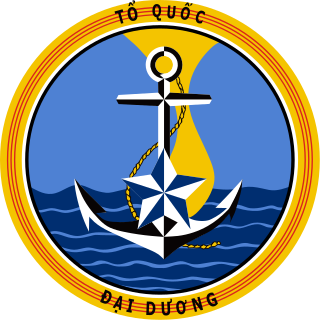
The Republic of Vietnam Navy was the naval branch of the South Vietnamese military, the official armed forces of the former Republic of Vietnam from 1955 to 1975. The early fleet consisted of boats from France; after 1955, and the transfer of the armed forces to Vietnamese control, the fleet was supplied from the United States. With American assistance, in 1972 the VNN became the largest Southeast Asian navy and, by some estimates, the fourth largest navy in the world, just behind the Soviet Union, the United States and the People's Republic of China, with 42,000 personnel, 672 amphibious ships and craft, 20 mine warfare vessels, 450 patrol craft, 56 service craft, and 242 junks. Other sources state that VNN was the ninth largest navy in the world. The Republic of Vietnam Navy was responsible for the protection of the country's national waters, islands, and interests of its maritime economy, as well as for the co-ordination of maritime police, customs service and the maritime border defence force.
The history of the United States Coast Guard goes back to the United States Revenue Cutter Service, which was founded on 4 August 1790 as part of the Department of the Treasury. The Revenue Cutter Service and the United States Life-Saving Service were merged to become the Coast Guard per 14 U.S.C. § 1 which states: "The Coast Guard as established January 28, 1915, shall be a military service and a branch of the armed forces of the United States at all times." In 1939 the United States Lighthouse Service was merged into the Coast Guard. The Coast Guard itself was moved to the Department of Transportation in 1967, and on 1 March 2003 it became part of the Department of Homeland Security. However, under 14 U.S.C. § 3 as amended by section 211 of the Coast Guard and Maritime Transportation Act of 2006, upon the declaration of war and when Congress so directs in the declaration, or when the President directs, the Coast Guard operates as a service in the Department of the Navy.

The term military medicine has a number of potential connotations. It may mean:
Hispanics in the United States Navy can trace their tradition of naval military service to men such as Lieutenant Jordi Farragut Mesquida, who served in the American Revolution. Hispanics, such as Seaman Philip Bazaar and Seaman John Ortega, have distinguished themselves in combat and have been awarded the Medal of Honor, the highest military decoration of the United States. Hispanics have also reached the top ranks of the navy, serving their country in sensitive leadership positions on domestic and foreign shores. Among those who have reached the highest ranks in the navy are Commodore Uriah Phillips Levy, of Sephardic and Ashkenazic Jewish descent, who participated in the War of 1812 as an assistant Sailing master; Admiral David Glasgow Farragut, for whom the rank of admiral in the U.S. Navy was created during the American Civil War; and Admiral Horacio Rivero, who led the navy during the Cuban Missile Crisis.
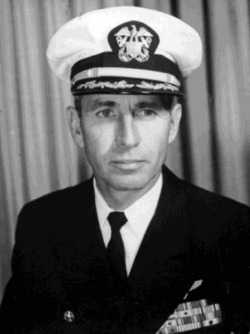
George Stephen Morrison was a United States Navy rear admiral and naval aviator. Morrison held significant commands of United States naval forces during the Vietnam War. He was the father of Jim Morrison, the lead singer of The Doors.
Lieutenant (abbreviated Lt, LT (U.S.), LT(USN), Lieut and LEUT, depending on nation) is a commissioned officer rank in many English-speaking nations' navies and coast guards. It is typically the most senior of junior officer ranks. In most navies, the rank's insignia may consist of two medium gold braid stripes, the uppermost stripe featuring an executive curl in many Commonwealth of Nations; or three stripes of equal or unequal width.











